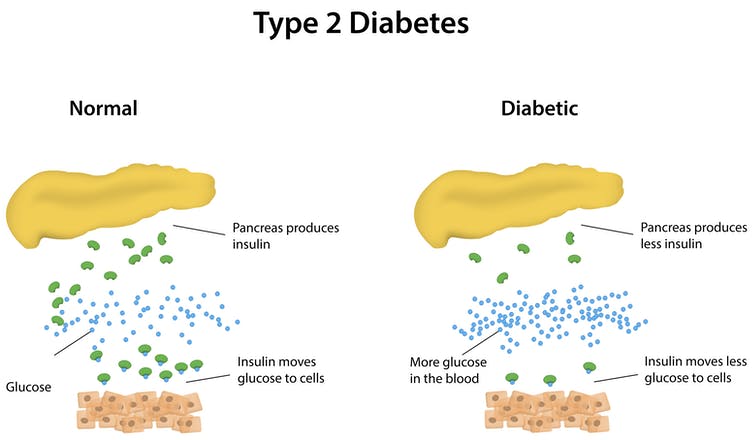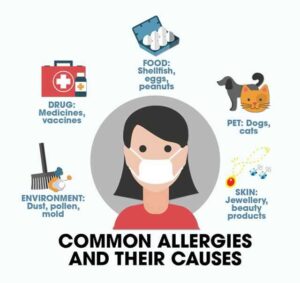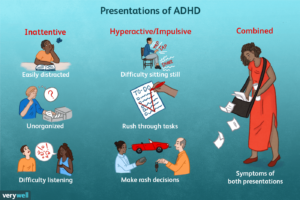Understanding Type 2 Diabetes

Understanding Type 2 Diabetes. Diabetes is a chronic medical condition in which sugar, or glucose, levels build up in your bloodstream. The hormone insulin helps move the glucose from your blood into your cells, where it’s used for energy.
In type 2 diabetes, your body’s cells aren’t able to respond to insulin as well as they should. In later stages of the disease, your body may also not produce enough insulin.
Uncontrolled type 2 diabetes can lead to chronically high blood glucose levels, causing several symptoms and potentially leading to serious complications.
Symptoms of type 2 diabetes
In type 2 diabetes, your body isn’t able to effectively use insulin to bring glucose into your cells. This causes your body to rely on alternative energy sources in your tissues, muscles, and organs. This is a chain reaction that can cause a variety of symptoms.
Type 2 diabetes can develop slowly. The symptoms may be mild and easy to dismiss at first. The early symptoms may include:
- constant hunger
- a lack of energy
- fatigue
- weight loss
- excessive thirst
- frequent urination
- dry mouth
- itchy skin
- blurry vision
As the disease progresses, the symptoms become more severe and potentially dangerous.
If your blood glucose levels have been high for a long time, the symptoms can include:
- yeast infections
- slow-healing cuts or sores
- dark patches on your skin, a condition known as acanthosis nigricans
- foot pain
- feelings of numbness in your extremities, or neuropathy
If you have two or more of these symptoms, you should see your doctor. Without treatment, diabetes can become life-threatening.
Causes of type 2 diabetes
Insulin is a naturally occurring hormone. Your pancreas produces it and releases it when you eat. Insulin helps transport glucose from your bloodstream to cells throughout your body, where it’s used for energy.
If you have type 2 diabetes, your body becomes resistant to insulin. Your body is no longer using the hormone efficiently. This forces your pancreas to work harder to make more insulin.
Over time, this can damage cells in your pancreas. Eventually, your pancreas may not be able to produce any insulin.
If you don’t produce enough insulin or if your body doesn’t use it efficiently, glucose builds up in your bloodstream. This leaves your body’s cells starved for energy. Doctors don’t know exactly what triggers this series of events.
It may have to do with cell dysfunction in the pancreas or with cell signaling and regulation. In some people, the liver produces too much glucose. There may be a genetic predisposition to developing type 2 diabetes.
There’s definitely a genetic predisposition to obesity, which increases the risk of insulin resistance and diabetes. There could also be an environmental trigger.
Most likely, it’s a combination of factors that increases the risk of type 2 diabetes. Find out more about the causes of diabetes.
Treatment for type 2 diabetes
You can effectively manage type 2 diabetes. Your doctor will tell you how often you should check your blood glucose levels. The goal is to stay within a specific range.
Follow these tips to manage type 2 diabetes:
- Include foods rich in fiber and healthy carbohydrates in your diet. Eating fruits, vegetables, and whole grains will help keep your blood glucose levels steady.
- Eat at regular intervals
- Only eat until you’re full.
- Control your weight and keep your heart healthy. That means keeping refined carbohydrates, sweets, and animal fats to a minimum.
- Get about half an hour of aerobic activity daily to help keep your heart healthy. Exercise helps to control blood glucose, too.
Your doctor will explain how to recognize the early symptoms of blood sugar that’s too high or too low and what to do in each situation. They’ll also help you learn which foods are healthy and which foods aren’t.
Not everyone with type 2 diabetes needs to use insulin. If you do, it’s because your pancreas isn’t making enough insulin on its own. It’s crucial that you take insulin as directed. There are other prescription medications that may help as well.
Medications for type 2 diabetes
In some cases, lifestyle changes are enough to keep type 2 diabetes under control. If not, there are several medications that may help. Some of these medications are:
- metformin, which can lower your blood glucose levels and improve how your body responds to insulin — it’s the preferred treatment for most people with type 2 diabetes
- sulfonylureas, which are oral medications that help your body make more insulin
- meglitinides, which are fast-acting, short-duration medications that stimulate your pancreas to release more insulin
- thiazolidinediones, which make your body more sensitive to insulin
- dipeptidyl peptidase-4 inhibitors, which are milder medications that help reduce blood glucose levels
- glucagon-like peptide-1 (GLP-1) receptor agonists, which slow digestion and improve blood glucose levels
- sodium-glucose cotransporter-2 (SGLT2) inhibitors, which help prevent the kidneys from reabsorbing glucose into the blood and sending it out in your urine
Each of these medications can cause side effects. It may take some time to find the best medication or combination of medications to treat your diabetes.
If your blood pressure or cholesterol levels are a problem, you may need medications to address those needs as well.
If your body can’t make enough insulin, you may need insulin therapy. You may only need a long-acting injection you can take at night, or you may need to take insulin several times per day. Learn about other medications that can help you manage diabetes.
Diet for type 2 diabetes
Diet is an important tool to keep your heart healthy and blood glucose levels within a safe and healthy range. It doesn’t have to be complicated or unpleasant.
The diet recommended for people with type 2 diabetes is the same diet just about everyone should follow. It boils down to a few key actions:
- Eat meals and snacks on schedule.
- Choose a variety of foods that are high in nutrients and low in empty calories.
- Be careful not to overeat.
- Read food labels closely.
Foods and beverages to avoid
There are certain foods and beverages that you should limit or avoid entirely. These include:
- foods heavy in saturated or trans fats
- organ meats, such as beef or liver
- processed meats
- shellfish
- margarine and shortening
- baked goods such as white bread, bagels
- processed snacks
- sugary drinks, including fruit juices
- high-fat dairy products
- pasta or white rice
Skipping salty foods and fried foods is also recommended. Check out this list of other foods and drinks to steer clear of if you have diabetes.
Foods to choose
Healthy carbohydrates can provide you with fiber. The options include:
- whole fruits
- non-starchy vegetables
- legumes, such as beans
- whole grains such as oats or quinoa
- sweet potatoes
Foods with heart-healthy omega-3 fatty acids include:
You can get healthy monounsaturated and polyunsaturated fats from a number of foods, including:
- oils, such as olive oil, canola oil, and peanut oil
- nuts, such as almonds, pecans, and walnuts
- avocados
Although these options for healthy fats are good for you, they’re also high in calories. Moderation is key. Opting for low-fat dairy products will also keep your fat intake under control. Discover more diabetes-friendly foods, from cinnamon to shirataki noodles.
The bottom line
Talk to your doctor about your personal nutrition and calorie goals. Together, you can come up with a diet plan that tastes great and suits your lifestyle needs.
Risk factors for type 2 diabetes
We may not understand the exact causes of type 2 diabetes, but we do know that certain factors can put you at increased risk.
Certain factors are out of your control:
- Your risk is greater if you have a brother, sister, or parent who has type 2 diabetes.
- You can develop type 2 diabetes at any age, but your risk increases as you get older. Your risk is particularly high once you reach 45 years old.
- African-Americans, Hispanic-Americans, Asian-Americans, Pacific Islanders, and Native Americans (American Indians and Alaska Natives) are at higher risk than Caucasians.
- Women who have a condition called polycystic ovarian syndrome (PCOS) are at increased risk.
You may be able to change these factors:
- Being overweight means that you have more fatty tissue, which makes your cells more resistant to insulin. Extra fat in the abdomen increases your risk more than extra fat in the hips and thighs.
- Your risk increases if you have a sedentary lifestyle. Regular exercise uses up glucose and helps your cells respond better to insulin.
- Eating a lot of junk foods or eating too much wreaks havoc on your blood glucose levels.
You’re also at increased risk if you’ve had gestational diabetes or prediabetes, two conditions caused by elevated glucose levels. Learn more about the factors that can increase your risk for diabetes.
Receiving a type 2 diabetes diagnosis
Whether or not you have prediabetes, you should see your doctor right away if you have the symptoms of diabetes. Your doctor can get a lot of information from blood work. Diagnostic testing may include the following:
- Hemoglobin A1C test. This test measures average blood glucose levels for the previous two or three months. You don’t need to fast for this test, and your doctor can diagnose you based on the results. It’s also called a glycosylated hemoglobin test.
- Fasting plasma glucose test. This test measures how much glucose is in your plasma. You may need to fast for eight hours before having it.
- Oral glucose tolerance test. During this test, your blood is drawn three times: before, one hour after, and two hours after you drink a dose of glucose. The test results show how well your body deals with glucose before and after the drink.
If you have diabetes, your doctor will provide you with information about how to manage the disease, including:
- how to monitor blood glucose levels on your own
- dietary recommendations
- physical activity recommendations
- information about any medications that you need
You may need to see an endocrinologist who specializes in the treatment of diabetes. You’ll probably need to visit your doctor more often at first to make sure your treatment plan is working.
If you don’t already have an endocrinologist, the Healthline FindCare tool can help you find a physician in your area.
Early diagnosis is key to proper diabetes management. Find out more about how type 2 diabetes is diagnosed.
Tips for how to prevent type 2 diabetes
You can’t always prevent type 2 diabetes. There’s nothing you can do about your genetics, ethnicity, or age.
However, a few lifestyle tweaks can help delay or even prevent the onset of type 2 diabetes, whether or not you have diabetes risk factors such as prediabetes.
Diet
Your diet should limit sugar and refined carbohydrates and replace them with low glycemic whole grains, carbohydrates, and fiber. Lean meat, poultry, or fish provide protein. You also need heart-healthy omega-3 fatty acids from certain kinds of fish, monounsaturated fats, and polyunsaturated fats. Dairy products should be low in fat.
It’s not only what you eat, but also how much you eat that matters. You should be careful about portion sizes and try to eat meals at about the same time every day.
Exercise
Type 2 diabetes is associated with inactivity. Getting 30 minutes of aerobic exercise every day can improve your overall health. Try to add in extra movement throughout the day, too.
Weight management
You’re more likely to develop type 2 diabetes if you’re overweight. Eating a healthy, balanced diet and getting daily exercise should help you keep your weight under control. If those changes aren’t working, your doctor can make some recommendations for losing weight safely.
The bottom line
These changes in diet, exercise, and weight management work together to help keep your blood glucose levels within the ideal range all day long.
Complications associated with type 2 diabetes
For many people, type 2 diabetes can be effectively managed. If not properly managed, it can affect virtually all of your organs and lead to serious complications, including:
- skin problems, such as bacterial or fungal infections
- nerve damage, or neuropathy, which can cause a loss of sensation or numbness and tingling in your extremities as well as digestive issues, such as vomiting, diarrhea, and constipation
- poor circulation to the feet, which makes it hard for your feet to heal when you have a cut or an infection and can also lead to gangrene and loss of the foot or leg
- hearing impairment
- retinal damage, or retinopathy, and eye damage, which can cause deteriorating vision, glaucoma, and cataracts
- cardiovascular diseases such as high blood pressure, narrowing of the arteries, angina, heart attack, and stroke
Hypoglycemia
Hypoglycemia can occur when your blood sugar is low. The symptoms can include shakiness, dizziness, and difficulty speaking. You can usually remedy this by having a “quick-fix” food or beverage, such as fruit juice, a soft drink, or a hard candy.
Hyperglycemia
Hyperglycemia can happen when blood sugar is high. It’s typically characterized by frequent urination and increased thirst. Exercising can help lower your blood glucose level.
Complications during and after pregnancy
If you have diabetes while you’re pregnant, you’ll need to monitor your condition carefully. Diabetes that’s poorly controlled can:
- complicate pregnancy, labor, and delivery
- harm your baby’s developing organs
- cause your baby to gain too much weight
It can also increase your baby’s risk of developing diabetes during their lifetime.
The bottom line
Diabetes is associated with a range of complications.
Women with diabetes are twice as likely to have another heart attack after the first one. Their risk of heart failure is four times that of women without diabetes. Men with diabetes are 3.5 times as likely to develop erectile dysfunction (ED).
Kidney damage and kidney failure can affect both women and men with the disease. Take these steps to lower your risk of kidney damage and other diabetes complications
Type 2 diabetes in children
Type 2 diabetes in children is a growing problem. According to the American Diabetes Association (ADA), around 193,000 Americans under age 20 have type 1 or type 2 diabetes. One study found that the incidence of type 2 diabetes in youth has increased to about 5,000 new cases per year. Another study showed a significant increase, particularly in minority races and ethnic groups.
The reasons for this are complex, but risk factors for type 2 diabetes include:
- being overweight, or having a body mass index above the 85th percentile
- having a birth weight of 9 pounds or more
- being born to a mother who had diabetes while she was pregnant
- having a close family member with type 2 diabetes
- having a sedentary lifestyle
- being African-American, Hispanic American, Asian-American, Native American, or a Pacific Islander
The symptoms of type 2 diabetes in children are the same as those in adults. They include:
- excessive thirst or hunger
- increased urination
- sores that are slow to heal
- frequent infections
- fatigue
- blurry vision
- areas of darkened skin
See your child’s doctor immediately if they have these symptoms.
In 2018, the ADA recommended that all children who are overweight and have additional diabetes risk factors be tested for prediabetes or type 2. Untreated diabetes can lead to serious and even life-threatening complications.
A random blood glucose test may reveal high blood glucose levels. A hemoglobin A1C test can provide more information about average blood glucose levels over a few months. Your child may also need a fasting blood glucose test.
If your child is diagnosed with diabetes, then their doctor will need to determine if it’s type 1 or type 2 before suggesting a specific treatment.
You can help lower your child’s risk by encouraging them to eat well and to be physically active every day.
Statistics about type 2 diabetes
The Centers for Disease Control and Prevention (CDC)Trusted Source report the following statistics about diabetes in the United States:
- Over 30 million people have diabetes. That’s around 10 percent of the population.
- One in four people have no idea they have diabetes.
- Prediabetes affects 84.1 million adults, and 90 percent of them are unaware of it.
- Non-Hispanic black, Hispanic, and Native American adults are about twice as likelyTrusted Source to have diabetes as non-Hispanic white adults.
The ADA reports the following statistics:
- In 2017, diabetes cost the United States $327 billion in direct medical costs and reduced productivity.
- The average medical expenses for people with diabetes are about 2.3 times higher than they would be in the absence of diabetes.
- Diabetes is the seventh leading cause of death in the United States, either as the underlying cause of death or as a contributing cause of death.
The World Health Organization (WHO)Trusted Source reports the following statistics:
- The 2014 global prevalence of diabetes was 8.5 percent for adults.
- In 1980, only 4.7 percent of adults worldwide had diabetes.
- Diabetes directly caused about 1.6 million deaths worldwide in 2016.
- Diabetes nearly triples the risk of heart attack and stroke in adults.
- Diabetes is also a leading cause of kidney failure.
Diabetes’ impact is widespread. It touches the lives of nearly half-a-billion of people around the world. View some infographics that shine a light on other diabetes statistics you should know.
Managing type 2 diabetes
Managing type 2 diabetes requires teamwork. You’ll need to work closely with your doctor, but a lot of the results depend on your actions.
Your doctor may want to perform periodic blood tests to determine your blood glucose levels. This will help determine how well you’re managing the disease. If you take medication, these tests will help gauge how well it’s working.
Because diabetes increases your risk of cardiovascular disease, your doctor will also monitor your blood pressure and blood cholesterol levels.
If you have symptoms of heart disease, you may need additional tests. These tests may include an electrocardiogram (ECG or EKG) or a cardiac stress test.
Follow these tips to help manage your diabetes:
- Maintain a balanced diet that includes non-starchy vegetables, whole-grains fiber, lean proteins, and unsaturated fats. Avoid unhealthy fats, sugars, and simple carbohydrates.
- Achieve and maintain a healthy weight.
- Exercise daily.
- Take all your medication as recommended.
- Use a home monitoring system to test your own blood glucose levels between visits to your doctor. Your doctor will tell you how often you should do that and what your target range should be.
It may also be helpful to bring your family into the loop. Educate them about the warning signs of blood glucose levels that are too high or too low so that they can help in an emergency.
If everyone in your home follows a healthy diet and participates in physical activity, you’ll all benefit.








